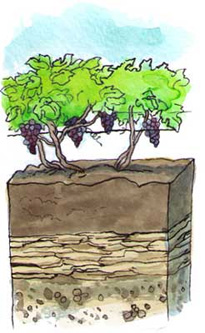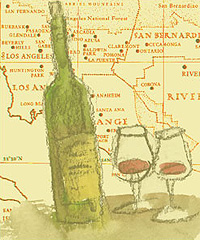

Looking beyond the dirt for the market imperative of terroir.
From the “Damn!..Wish I’d Written That” Department:
''Talk Dirt to Me'' by McGee & Patterson in the Sunday New York Times
by
Roger Dial
May 8, 2007
This piece by Harold McGee and Daniel Patterson is a MUST READ for all wine professionals and enthusiasts who care where our wine culture is headed.
First, McGee and Patterson have managed to demystify one component (soil) of what I call “the terroir complex”, without throwing the whole baby ("somewhereness") out with the dirt. Secondly, (hopefully) their article in this Sunday’s New York Times will edge the terroir conversation along the road that it needs to go, lest it forever continues to be merely a narrow polemic between traditionalists and modernists on the question of technological intervention.
McGee and Patterson quite rightly point out that, for marketing reasons, the traditional identity of wine was built around the terroir complex (including the localized human element) that, taken as a whole, is "somewhereness" (to use Matt Kramer’s lovely term).
Marketing!!...perish the thought! Yep, those old Euro-guys put their money on the marketing notion that what the consumers wanted was distinctive, place-identified diversity in wine. They decided that it would be to their ($$$) advantage if Chablis did NOT taste like Montrachet or Meursault or Macon. (For the record, after Pasteur, they could have made those wines taste pretty much the same, and today such a cross-appellation homogenization of flavor profiles could happen instantly…and, in many cases, is happening!).
For the low-end consumer of that bygone era (and now), place identity simply became a reliable distinctive brand, mixed perhaps with a sense of parochial pride if the vineyards in question could be seen from the kitchen window. More importantly, for the higher-end consumer, diversity (of place taste) expanded interest and enhanced the value of wines that clearly expressed "somewhereness".

For a domestic wine industry of some 5K producers to be sustainable, diversity expressed in terms of carefully nurtured and distinctive appellation identities is crucial.
So, does an age-old marketing decision to accentuate place identity and diversity have any utility today? My hunch is that the narrow taste profile recipe book currently in vogue, which produces so-called "international style" wine in both the new and old appellations around the globe, may work for the 2-Buck-Chuck consumer niche. And that’s good.
However, I’m even more convinced that this one-dimensional, laboratory-driven wine will diminish rather than expand interest and deflate rather than enhance value for the wine enthusiasts who have defined the wine culture to date. And that’s bad!
At APPELLATION AMERICA, we believe that "somewhereness" diversity, expressed in terms of carefully nurtured and distinctive appellation identities, is the way to go. Not because we’re old fashioned, delusionary terroir romanticists. But, because we are market futurists who think there has to be a reason for the existence of 250+ separate winegrowing regions and upwards of 5,000 wineries in our part of the world.
I congratulate Harold McGee and Daniel Patterson for their stimulating article…wish I’d written it!
For more on this subject that Roger Dial did write:
First, McGee and Patterson have managed to demystify one component (soil) of what I call “the terroir complex”, without throwing the whole baby ("somewhereness") out with the dirt. Secondly, (hopefully) their article in this Sunday’s New York Times will edge the terroir conversation along the road that it needs to go, lest it forever continues to be merely a narrow polemic between traditionalists and modernists on the question of technological intervention.
McGee and Patterson quite rightly point out that, for marketing reasons, the traditional identity of wine was built around the terroir complex (including the localized human element) that, taken as a whole, is "somewhereness" (to use Matt Kramer’s lovely term).
Marketing!!...perish the thought! Yep, those old Euro-guys put their money on the marketing notion that what the consumers wanted was distinctive, place-identified diversity in wine. They decided that it would be to their ($$$) advantage if Chablis did NOT taste like Montrachet or Meursault or Macon. (For the record, after Pasteur, they could have made those wines taste pretty much the same, and today such a cross-appellation homogenization of flavor profiles could happen instantly…and, in many cases, is happening!).
For the low-end consumer of that bygone era (and now), place identity simply became a reliable distinctive brand, mixed perhaps with a sense of parochial pride if the vineyards in question could be seen from the kitchen window. More importantly, for the higher-end consumer, diversity (of place taste) expanded interest and enhanced the value of wines that clearly expressed "somewhereness".

For a domestic wine industry of some 5K producers to be sustainable, diversity expressed in terms of carefully nurtured and distinctive appellation identities is crucial.
So, does an age-old marketing decision to accentuate place identity and diversity have any utility today? My hunch is that the narrow taste profile recipe book currently in vogue, which produces so-called "international style" wine in both the new and old appellations around the globe, may work for the 2-Buck-Chuck consumer niche. And that’s good.
However, I’m even more convinced that this one-dimensional, laboratory-driven wine will diminish rather than expand interest and deflate rather than enhance value for the wine enthusiasts who have defined the wine culture to date. And that’s bad!
At APPELLATION AMERICA, we believe that "somewhereness" diversity, expressed in terms of carefully nurtured and distinctive appellation identities, is the way to go. Not because we’re old fashioned, delusionary terroir romanticists. But, because we are market futurists who think there has to be a reason for the existence of 250+ separate winegrowing regions and upwards of 5,000 wineries in our part of the world.
I congratulate Harold McGee and Daniel Patterson for their stimulating article…wish I’d written it!
For more on this subject that Roger Dial did write:
- Why Build Appellation Consciousness? An open letter from the Publisher
- Zorg and Mok Feel the Rumbles of Paradigmatic Shift










 READER FEEDBACK: To post your comments on this story,
READER FEEDBACK: To post your comments on this story,





